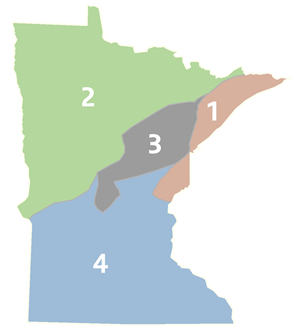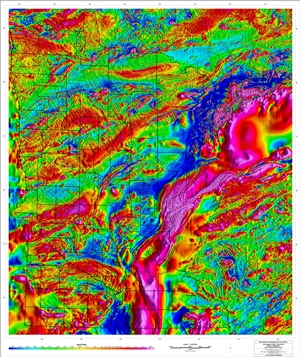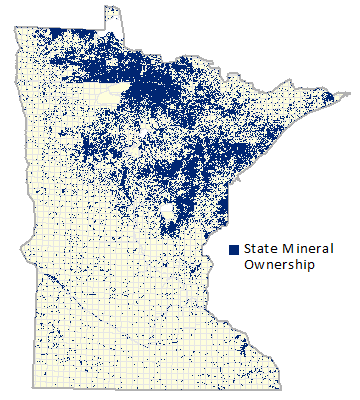Minnesota
Minerals Coordinating Committee
Explore Minnesota Minerals
Text taken from the following document: 'Explore Minnesota Minerals'
A century of iron mining has barely scratched the surface of Minnesota’s mineral wealth. Thousands of square miles of Minnesota encompassing promising greenstone belts, sedimentary basins and intrusives await exploration. We invite you to explore Minnesota. Here are seven reasons to accept our invitation:
-
Minnesota has land for exploration. Your company will have access to nearly 12 million acres of stateowned mineral rights available for long-term lease. Learn more »
-
Minnesota has excellent mineral potential. Much of Minnesota’s geologic terrane is a continuation of the mineral-rich Canadian Shield of Ontario and Quebec, which has yielded gold, silver, zinc, copper, nickel, titanium, and other precious metals and base metals. Learn more »
-
Minnesota has an extensive geological database. Drill core totaling more than three million feet, collected from many areas and formations, has been stored and cataloged for your reference and analysis. Geologic maps and results of geophysical and geochemical surveys are also available. Learn more »
-
Minnesota has a century-long tradition of mining. Since the first load of iron ore was shipped from northern Minnesota more than 100 years ago, Minnesotans have realized the benefits of mineral development. The state’s strong environmental regulations are well established and administered equitably. We make regulatory decisions promptly and predictably according to well-established precedents. Learn more »
-
Over $2 billion in capital has been invested in mining in the last 5 years. Mining companies are investing in their Minnesota future.
-
Minnesota has trained workers and support industries. A skilled labor force and network of support industries have grown to support Minnesota’s mining industry; so when you need labor or supplies, you won’t have far to look. Learn more »
-
Minnesota has roads, rails, and power. No matter where you go in Minnesota, you’re never far from the highways, railroads, ports and utilities you need to get your development off the ground. Learn more »

Figure 1 - Generalized geologic bedrock map of Minnesota
Excellent Mineral Potential
Minnesota’s diverse bedrock geology ranges from early Archean to Cretaceous (Fig. 1). The state’s greatest mineral potential lies in its extensive Precambrian geology, of which four terranes are particularly promising:
-
1) The Duluth Complex and associated rocks. This terrane contains most of the state’s active non-ferrous mineral leases. The Minnesota Department of Natural Resources (DNR) estimates the identified copper-nickel resource of the area at about 4.4 billion tons averaging 0.66% copper and 0.2% nickel. This terrane also has significant titanium resources. Drilling has indicated the presence of other strategic minerals, such as chromium, vanadium, cobalt, and platinum-group elements.
-
2) The Superior Province, which encompasses the northwestern third of Minnesota and represents a continuation of the mineral-rich Canadian Shield. Canadian gold discoveries have stimulated leasing in the Minnesota portion of the Superior Province. Most exploration in this area has been for gold, zinc-copper massive sulfides with various by-products, and magmatic sulfide deposits containing copper, nickel, and platinumgroup elements.
-
3) Variably metamorphosed Middle Precambrian sedimentary and volcanic rocks, including the Mesabi and Cuyuna iron ranges, with known reserves of iron and manganese. Recent exploration has focused on base metals.
-
4) Southern Minnesota’s Archean migmatitic gneisses, younger sedimentary rocks, batholithic granitic rocks and deformed volcanics. Limited exploration has focused on Precambrian magmatic copper + nickel + PGM deposits, Paleozoic lead-zinc deposits in the southeast, base metals and precious metals in the Precambrian basement, and manganese in the southwest.
Commodity information (open referenced documents for full information - Updated in March of 2016):
This set of documents describe the status of mineral exploration and development current activities for iron ore, the group copper and nickel and platinum and palladium, for gold, for titanium, and for diamonds. Each of these has seen private investment in either exploration or development or both.
-
Iron-Ore: Minnesota is a mining state. Its six iron ore operations produce about 40 million tons of high-grade iron ore annually, which is approximately 75 percent of total U.S. iron ore production. To produce 40 million tons of high-grade iron ore, Minnesota moves on the order of 240 million tons of material including 135 million tons of crude ore and 105 million tons of surface and rock stripping.
-
Copper-Nickel: Minnesota’s known copper-nickel±platinum group elements deposits that have received the most attention, including the several deposits now being considered for possible near-term development, are located within the 1.1 billion-year-old Duluth Complex, one of the great mafic igneous complexes of the world. The Duluth Complex is the major intrusive component of the Midcontinent Rift, a failed, horseshoe-shaped, intracontinental rift system that is exposed in the Lake Superior Region.
-
Titanium: Northeastern Minnesota has ilmenite-rich deposits associated with the gabbroic intrusive Duluth Complex. Titanium oxide produced from the minerals ilmenite, rutile, leucoxene, and synthetic rutile is the predominant white pigment used in paints, paper, and plastics in a multi-billion dollar market in the United States. In addition, titanium is also essential to aerospace, military, and medical applications. In 2003, ilmenite accounted for 93 percent of world titanium mineral production (5.3 million tons), with most of the supply coming from Australia, South Africa, and Canada.
-
Gold: Exploration companies are actively drilling gold prospects on state-owned mineral leases in Minnesota’s Superior Province granite-greenstone terranes. The Archean Superior Province greenstone belts that host many of Canada’s richest gold camps continue along strike across the U.S. border and into the northern portion of Minnesota. The potential for gold production in Minnesota’s portions of the Wawa and Wabigoon Subprovinces is excellent, and the exploration models used for nearby gold deposits in Northwestern Ontario (e.g. Rainy River, Hammond Reef, Moss Lake/Shebandowan), should be considered.
-
Diamonds: Minnesota is underexplored for diamonds. There has been limited exploration for diamonds by Exmin, a subsidiary of Sibeka (Belgium), that identified garnets, ilmenite, chrome spinel, and chrome diopside. Yet, Minnesota is underlain by the Archeanaged Superior Craton (after Kirkley et al., 1991, Gems and Gemology, with permission) that contains diamondiferous kimberlites, diamondiferous lamprophyres, and related heterolithic breccias/volcaniclastic sediments.
Text taken from the following document: 'Explore Minnesota: Iron Ore'
Text taken from the following document: 'Explore Minnesota: Copper-Nickel'
Text taken from the following document: 'Explore Minnesota: Titanium'
Text taken from the following document: 'Explore Minnesota: Gold'
Text taken from the following document: 'Explore Minnesota: Diamonds'
Extensive Geological Database

Figure 2 - Minnesota Geological Survey computer-generated aeromagnetic anomaly map. Image is reduced in size and density; color added. See full-sized PDF
When you explore Minnesota’s geology, you have direct access to an extensive geological database. An important source of information is the large, well-cataloged drill-core library, which houses for your inspection and analysis about two million feet of diamond drill core, referenced to exact descriptions of hole locations. The library includes drill core samples taken from across the state during the past century.
Logs, assays, geophysical, and geochemical surveys are available to you in Department of Natural Resources’ (DNR) exploration company terminated lease files. The DNR’s Division of Lands and Minerals can provide information about state land leasing, royalty rates, reclamation guidelines, and other pertinent facts.
Geologic maps and outstanding high-resolution aeromagnetic maps (Fig. 2) of much of the state have been published by the Minnesota Geological Survey. Aeromagnetic data are available on colored and black-and-white contour maps, on computer-generated shaded relief maps, and for download for your own interpretation.
Much of the information you need is stored on a web server and can be accessed at http://minarchive.dnr.state.mn.us. More and more records are being made digital and web accessible. These public documents provide a rich source of information for future exploration, environmental research, and historical minerals research.

Figure 4 - The map depicts 40-acre tracts of state mineral ownership
Land for Exploration
If you have a target mineralization model in mind, you can test it in the nearly 12 million acres of mineral rights the state administers. Neither the state nor the federal government uses the claim-staking method in Minnesota. Each year the state awards leases for state-owned mineral rights according to competitive royalty bids. Areas that have no competitive bids later become available through lease by application. Under some circumstances, state leases can be negotiated. Fifty-year leases cover exploration and mining; so you can secure a good land position early in your program.
Moreover, mineral leases are available on many of the 3.4 million acres of federal land in Minnesota. Some 82 percent of this land is managed by the U.S. Forest Service in the Chippewa National Forest in north-central Minnesota and the Superior National Forest in the northeast.
Leases also can be negotiated on millions of acres of privately held mineral rights in the state (Fig. 4). Public land and mineral rights are scattered throughout Minnesota but are most concentrated in the north. Exploratory drilling has been heaviest in the northeast, especially on the Mesabi, Vermilion, and Cuyuna iron ranges.
Century-Long Tradition of Mining
Though excellent mineral potential is essential to an exploration program, it alone is not enough. A company also must be reasonably assured that if it finds a worthwhile deposit it can mine, and not be hamstrung by delays.
In Minnesota, this assurance comes in the form of well-defined procedures that have evolved during a century of mining for iron, taconite, dimension stone, silica sand, and other materials. This long association with mining has taught Minnesotans how to accommodate mineral development while protecting the environment and the state’s own economic interests.
Minnesota’s strong environmental regulations, well-established permitting procedures, and long-standing leasing laws are in place. Staff members from the DNR’s Division of Lands and Minerals and other state regulatory agencies are available to meet with your company to explain these rules and advise you on permitting procedures.

Figure 5 - More than 100 million tons of taconite ore are mined per year in Minnesota
Trained Workers and Support Industries
Minnesotans know mining (Fig. 5). When you explore for minerals or mine in Minnesota, you have access to skilled, educated workers, established mining-supply companies, and experienced consultants.
Minnesota has a strong system of universities, technical/vocational institutions, and public and private colleges. Its labor force is highly educated. Minnesota’s high-school completion rate is better than 90 percent. About half of these graduates pursue some kind of postsecondary education. Decades of iron mining have fostered the growth of miningrelated industries. The taconite mining industry purchases goods and services from hundreds of supplier/vendor businesses in more than 200 communities. Whether you need drill bits or shovel repairs or geophysical consultants, you can find them in Minnesota.

Figure 6 - Roads, rails, Lake Superior ports, and power plants that are related to mining on the Mesabi Iron Range and the developing Cu-Ni-PGE mineral deposits of the Duluth Complex. See full-sized PDF
Roads, Rails, Ports, and Power
Any site you explore or mine is within reach of freight haulers and power lines (Fig. 6). Highways reach all corners of the state. Even in the sparsely settled north, little land is more than a few miles from all-weather highways suitable for large trucks.
More than 4,500 miles of railroad track connect all Minnesota cities larger than 25,000 and link the state to major cities and ports throughout the country. Minnesota has four classone rail carriers: Burlington Northern Santa Fe, Canadian National, Canadian Pacific, and Union Pacific. Several regional lines operate in Minnesota as well.
Minnesota’s northern country borders the state’s four Great Lakes cargo ports. Duluth-Superior, a foreign-trade zone operated by a port authority, ships taconite pellets, coal, grain, and other commodities. The other three ports—Two Harbors, Taconite Harbor, and Silver Bay—handle taconite pellets.
Mississippi River ports in southeastern Minnesota ship coal, chemicals, stone, clay, gravel, and other raw materials.
Reliable electricity is available at competitive rates across the state through a network of power suppliers. Natural gas pipelines of substantial capacity span southern Minnesota and much of northern Minnesota.
For more information, contact:
Mineral Leasing
Minnesota Department of Natural Resources
Division of Lands and Minerals
500 Lafayette Road
St. Paul, MN 55155-4045
Tel. 651-259-5959
Web. www.dnr.state.mn.us
Drill Core Library, Economic Geology, Exploration, Reclamation
Minnesota Department of Natural Resources
Division of Lands and Minerals
1525 Third Avenue East
Hibbing, MN 55746
Tel. 218-231-8484
Web. www.dnr.state.mn.us
Geologic Information, Aeromagnetic Maps
Minnesota Geological Survey
University of Minnesota
2642 University Avenue West
St. Paul, MN 55114-1057
Tel. 612-627-4780
Web. www.mngs.umn.edu
Economic Development
Natural Resources Research Institute
University of Minnesota, Duluth
5013 Miller Trunk Highway
Duluth, MN 55811-1442
Tel. 218-720-4294
Web. www.nrri.umn.edu









